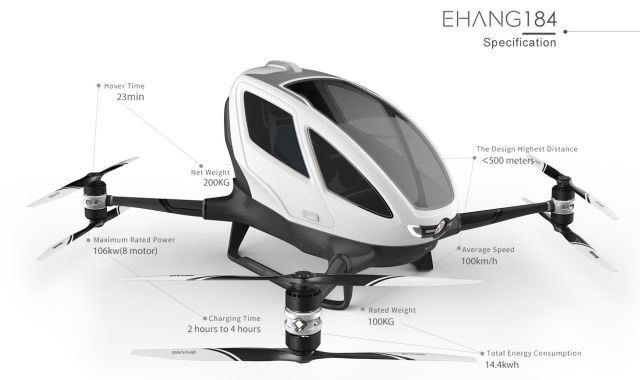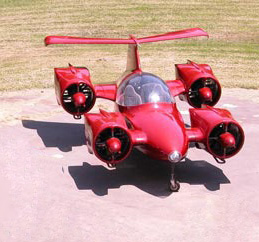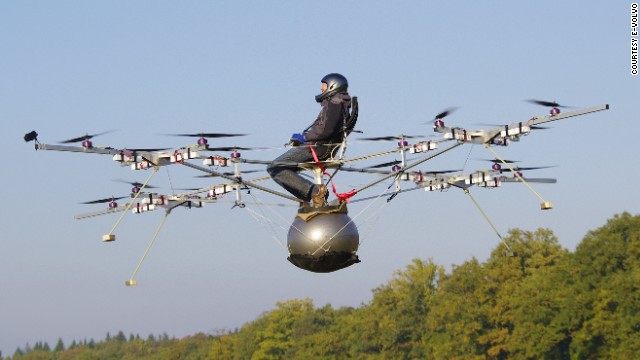My final thought is that this is still safer than trying to drive in a major metropolitan area in China
You are using an out of date browser. It may not display this or other websites correctly.
You should upgrade or use an alternative browser.
You should upgrade or use an alternative browser.
News on China's scientific and technological development.
- Thread starter Quickie
- Start date
Haha, I guess soChinese company unveils world’s first passenger drone at CES
Would you trust your life to an autonomous flying vehicle?
by (UK) - Jan 8, 2016 12:33am AEST

The Chinese startup company Ehang unveiled yesterday at CES what it claims is the first passenger drone, capable of carrying one person for about 20 minutes. According to : "The cabin fits one person and a small backpack and is fitted with air conditioning and a reading light. It is designed to fit, with propellers folded, in a single parking spot." The company hopes to sell the device for $200,000 to $300,000 (£140,000 to £200,000) later this year.
The (AAV) weighs 200 kilograms (440lbs), and has four sets of paired electric motors. The company claims the batteries can be charged in two to four hours. The drone is controlled via a tablet, which is used to set the flight path before take-off. According to the company's website: "Ehang 184 AAV flies in a inverted U shape. It takes off and lands vertically, point to point direct flight based on altitude and latitude of the origin and termination point. Take Off/Landing points are landing targets pre-set with Ehang Logo. The landing camera will position the landing targets automatically and accurately."
Since the passenger has zero inflight control over the machine, safety is naturally a major concern. The company claims: "Even with one propeller malfunctions, it can still land in the nearest possible area safely." In addition, if any other components malfunction or disconnect, "the aircraft will immediately land in the nearest possible area to ensure safety."
According to The Guardian, the company also says it is planning to set up a remote control centre that would take over the vehicle if there were a problem. , the vehicle has been flown more than 100 times at low altitudes in a forested area in Guangzhou, where Ehang is based, including several times with a person on board.
, and has raised over $50 million (£34 million) in capital from various investors. It is best known for . The Ehang 184 represents an ambitious extension of its activities beyond these smaller, traditional drones.
At a time when authorities around the world are clamping down on the use of unmanned drones, it is not clear how one that carries passengers will be received. Unlike for autonomous cars, which are gaining wider acceptance, the margin for error with autonomous flying vehicles is rather small. Nor is it obvious who might want to buy and use such a passenger drone.
This company goes from a toy drone maker to a full fledge flying passenger transport maker. Would you trust them? I don't know. One Youtube comment says "Nothing about this thing look safe to me especially with it being low altitude. With eight blades to contend with, it looks like a human salad maker with red dressing....."
What's most interesting is that they have ACTUALLY test-flight this with people inside the craft several times, and this doesn't look like a vapourware like that Moller Skycar M400 which has been in development for well over 40 years and still have nothing to show for.

EDIT: LOL ! Newguy02 you beat me to it by a few minutes. Guess we saw the same news.
Ultra
Junior Member
My bet is they'll have to change the position of the rotor chassis above not below.
Changing it to above basically making it a helicopter. Which will beg the question why not just make it ONE main rotor (with counter-rotating rotor above) like the traditional helicopter which is simpler and cheaper (one main rotor vs 4 / 8 rotors).
Another thing I noticed is that the rotor blades for Ehang is incredibly small. That really begs the question of efficiency - is it better to have just a large traditional rotor bade than 4 tiny propeller blades? I am sure the answer is 1 big one gives much greater lift and efficiency.
Finally, they talked about having a "support/command center" in case of emergency - I thought that just sounds incredibly bad as a marketing ploy - first, everyone knows it will be underfunded, it will just be a "token" service with skeletal crews - how are you going to benefit from it if you are half way around the world from China (let's say Saskatchewan, Canada) flying over place with no internet connection and motors and systems suddenly fail? Are these people going to land it for you? Are they going to direct emergency crew to your position half-way around the world to place they have no idea and never been to?
And worse of all, if this "command center" can remotely controlled your craft incase of emergency, who is to say this won't be abused by the staff? Or maybe even Chinese government? Who's to say this wont' be hacked?
Last edited:
Quickie
Colonel
It'll increase its stability tremendously( and thereby safety) which is a plus when there is an engine failure. I wonder why they haven't done so yet.My bet is they'll have to change the position of the rotor chassis above not below.
Quickie
Colonel
I can't edit my earlier post.
There is a reason why the rotors are not placed at a higher position. The down draft from the higher positioned rotors would push the craft down reducing the effectiveness of the rotors it-selves. The four rotors could be placed further apart at a higher position but that would reduce the compactness of the drone.
There is a reason why the rotors are not placed at a higher position. The down draft from the higher positioned rotors would push the craft down reducing the effectiveness of the rotors it-selves. The four rotors could be placed further apart at a higher position but that would reduce the compactness of the drone.
Ultra
Junior Member
My bet is they'll have to change the position of the rotor chassis above not below.
Turns out there is already one under development by German company Volocopter:


And this one is a twin-seater!
TerraN_EmpirE
Tyrant King
Yet another flying car dream just retagged with the term drone. Only major change being the control system being automated. The questions of price practicalities and legality have yet to be answered making this very possible vaporware. Worst case a dead end, middle road development of military /government equipment best case is a stretch. A single seat quad rotor operated by a automated navigation system is a stretch for mainstream civilian use.
Equation
Lieutenant General
Changing it to above basically making it a helicopter. Which will beg the question why not just make it ONE main rotor (with counter-rotating rotor above) like the traditional helicopter which is simpler and cheaper (one main rotor vs 4 / 8 rotors).
Another thing I noticed is that the rotor blades for Ehang is incredibly small. That really begs the question of efficiency - is it better to have just a large traditional rotor bade than 4 tiny propeller blades? I am sure the answer is 1 big one gives much greater lift and efficiency.
Finally, they talked about having a "support/command center" in case of emergency - I thought that just sounds incredibly bad as a marketing ploy - first, everyone knows it will be underfunded, it will just be a "token" service with skeletal crews - how are you going to benefit from it if you are half way around the world from China (let's say Saskatchewan, Canada) flying over place with no internet connection and motors and systems suddenly fail? Are these people going to land it for you? Are they going to direct emergency crew to your position half-way around the world to place they have no idea and never been to?
And worse of all, if this "command center" can remotely controlled your craft incase of emergency, who is to say this won't be abused by the staff? Or maybe even Chinese government? Who's to say this wont' be hacked?
Support/Command center can be in state with FAA approval of course.
Equation
Lieutenant General
Yet another flying car dream just retagged with the term drone. Only major change being the control system being automated. The questions of price practicalities and legality have yet to be answered making this very possible vaporware. Worst case a dead end, middle road development of military /government equipment best case is a stretch. A single seat quad rotor operated by a automated navigation system is a stretch for mainstream civilian use.
Heck even main stream civilian can't afford a Tesla much less a flying drone, but at least China is making it more affordable to anyone with money to afford one.
